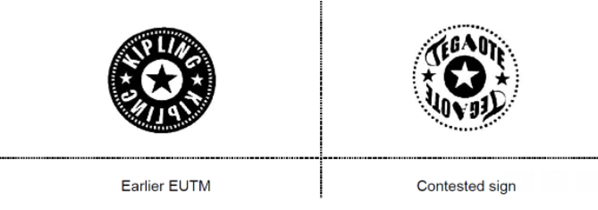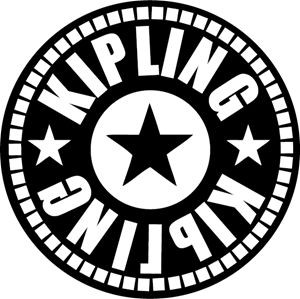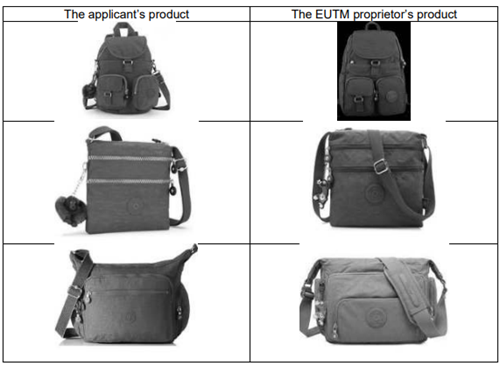

The scope of protection of the ‘well-known’ Kipling logo
The scope of protection of trademarks with reputation is therefore broader. For example, infringement can also be presumed for a trademark with reputation if the younger trademark ‘takes unfair advantage of the distinctive character or reputation of the prior –trademark (with reputation)’. In short, this is the case if the marketing of products under the younger trademark is facilitated, because an association is created with the prior, trademark with reputation. As an example we will use the case of the Kipling logo, which is registered as an EU figurative mark. The owner of that trademark argues that the Kipling figurative mark is a trademark with reputation and that another logo takes unfair advantage of the reputation of the Kipling figurative mark with reputation.
Revocation of a younger trademark
The aforementioned distinction in infringement cases also applies to so-called revocation actions against younger trademarks that are registered in the trademark register. If a younger trademark is registered in the trademark register, that trademark registration can still be declared invalid at a later stage on the basis of a prior trademark.
The following criteria are important for a revocation test for trademarks with reputation:
- The marks (word and figurative elements) included in both trademarks are identical or similar (a certain low degree of similarity may be sufficient in certain circumstances);
- The prior trademark must have a reputation. It is important for the trademark to have a reputation before the younger trademark has been filed. In addition, it is important that this reputation is still present at the time the revocation action is instituted;
- Damage to reputation. This may be the case when the younger trademark takes unfair advantage of the distinctive character or reputation of the prior –trademark with reputation.

Case - KIPLING vs. TEGAOTE
On 14 July 2021, the owner of the Kipling figurative mark, VF International, initiated a revocation action with the European Trademark Authority (EUIPO) against the TEGAOTE figurative mark, registered since 18 May 2018. According to VF International, the reputation of its EU figurative mark in relation to Kipling bags is being affected. In other words, according to VF International, the registration of the younger TEGAOTE figurative mark for bags takes unfair advantage of the distinctive character or reputation of its Kipling figurative mark.
1. Similar marks
The first question that arises is whether there are any similar marks at all. It is settled case-law that word elements of trademarks are the most important, such as ‘KIPLING’ and ‘TEGAOTE’ in the logos of both trademarks. In this case, the ‘KIPLING’ and ‘TEGAOTE’ marks are quite different from each other, but figurative marks concern the degree of similarity between the figurative marks as a whole (the two logos). Certain figurative elements in both logos do show similarities.
‘Decorative elements’ such as the circle and the star in the logo are not very distinctive trademark elements. Due to the equal size of the circle elements and the identical position of the three stars in both trademarks, there is an admittedly low degree of similarity. Based on this, we look at the second criterion: is the prior trademark a trademark with reputation?
2. Trademark with reputation?
How well known is the prior EU figurative mark in relation to Kipling bags? We test this question in a legal sense: a trademark has a reputation if the prior trademark is well known to a significant part of the relevant public for Kipling bags. Several factors play a role in this assessment:
- What is the trademark’s market share?
- How intensively are the trademark and products used? Are annual sales substantive?
- Where are the Kipling bags being sold (geographical scope)?
- How long has the trademark been registered (the duration of trademark use)?
- What is the scope of investment to promote the trademark?

VF International argues that the EU figurative mark has a reputation for the bags, particularly in Belgium, the Netherlands and France, due to intensive use. Evidence has been submitted in support of this claim, showing that the EU trademark is displayed on almost all bags marketed by VF International. The sales of the bags amount to between 76 and 116 million euros annually, according to the submitted evidence.
The EUIPO concludes from the submitted evidence that the Kipling figurative mark is used long and intensively. As a result, the trademark has a reputation, which means it takes up an important position among the most important trademarks in this market segment. The sales figures, marketing spend and brand awareness evidenced by the evidence show that the trademark has a reputation among the relevant public buying bags.
3. Damage to the reputation of the prior trademark
Before assessing whether the reputation of the Kipling figurative mark is indeed affected, it must be assessed whether the trademarks can be associated with each other. If there is a certain link between the two trademarks, it is assessed whether there is an unfair advantage.
3.1. Is there a risk of association?
Relevant factors in confirming association or not are:
- The degree of similarity between the marks;
- The nature of the products, including the degree of similarity or difference between these products;
- The strength of the reputation of the prior Kipling trademark;
- The distinctive character of the prior trademark;
- Whether there is a risk that the relevant public will confuse the trademarks with each other.
An important addition to the above points is that there can already be association if there is a small degree of similarity. In particular, because the younger trademark is registered for identical products (bags), the relevant public can establish a link between the trademarks. The relevant public buying bags in a store attaches great importance to visual similarities, such as figurative elements within the logo.
3.2. Is there an Unfair advantage?
The key question is whether registration of the TEGAOTE figurative mark takes unfair advantage of the Kipling figurative mark with reputation. The risk of confusion is therefore not a requirement.
First of all, it was concluded that there is a low degree of similarity between the figurative marks. The second conclusion is that the Kipling figurative mark enjoys a high degree of reputation among the relevant bag-buying public. Third, the figurative marks will be associated with each other due to several factors, despite the low degree of similarity between the marks of the two trademarks. Finally, the EUIPO attaches great importance to the fact that the younger TEGAOTE figurative mark appears on bags that are suspiciously similar to Kipling’s - see the image below:

Based on the above findings, it is likely that when purchasing bags of the younger brand, the relevant public will believe that the TEGAOTE figurative mark is related to the prior figurative Kiping trademark with reputation, despite the fact that there need not be any confusion between the brands. That may boost sales of TEGAOTE bags, while TEGAOTE has not made any substantial investments in its brand. TEGAOTE takes unfair advantage (free riding) from the investments made by VF International in respect of the prior Kipling figurative mark.
The younger brand thus takes unfair advantage of the distinctive character of the Kipling figurative mark with reputation. TEGAOTE also affects the reputation of the prior Kipling figurative mark. Based on these two conclusions, the EUIPO declares the TEGAOTE figurative mark invalid for bags.
Conclusion
An important lesson for ‘well-known’ trademark owners is to document investments in brand promotion and market share. Trademark infringement can be presumed for these brands, even if there is no risk of confusion. The trademark authority will not officially recognise that a trademark has a reputation. The trademark owner must provide evidence demonstrating legal reputation. The bar to prove that a trademark has a reputation from a legal point of view is set quite high.
The fact that things do go wrong with the documentation and presentation of evidence is demonstrated by the so-called Big Mac case. In this instance, McDonald’s was unable to prove that its Big Mac trademark was ‘used genuinely in a legal sense. Therefore, the trademark was removed from trademark registration. Cases like this are a wake-up call for trademark owners to properly document trademark use, so the trademark owner can continue to invoke its (well-known) trademark.
Kenmerkend newsletter
This article is part of Kenmerkend, the newsletter of NLO Shieldmark. In this quarterly newsletter you can read interesting articles about trademarks & designs models and the latest news from NLO Shieldmark. Would you like to stay informed? Subscribe to our newsletter!
Subscribe


